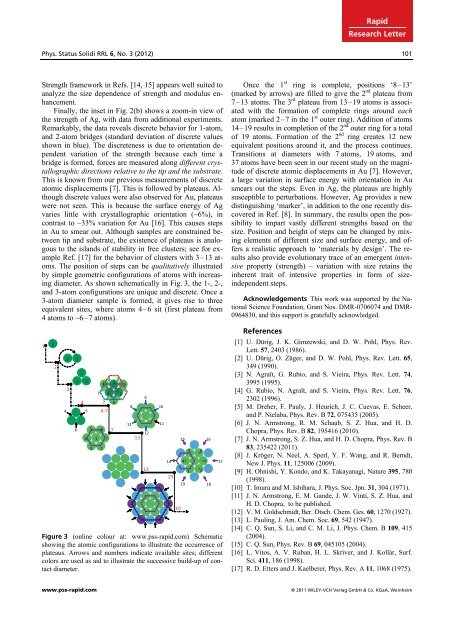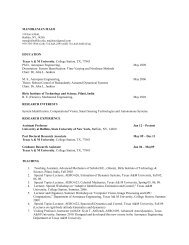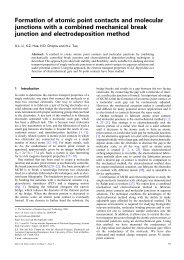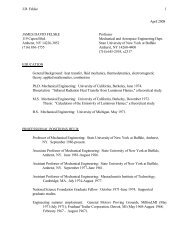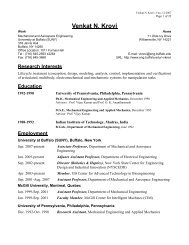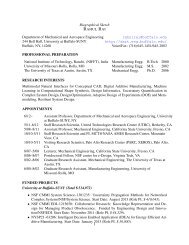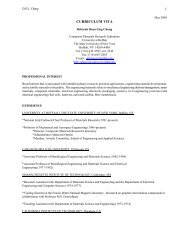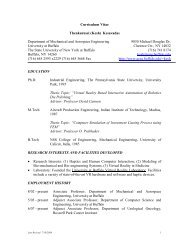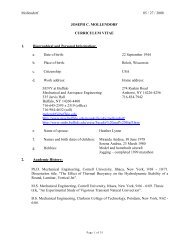physica status solid.. - Mechanical and Aerospace Engineering
physica status solid.. - Mechanical and Aerospace Engineering
physica status solid.. - Mechanical and Aerospace Engineering
You also want an ePaper? Increase the reach of your titles
YUMPU automatically turns print PDFs into web optimized ePapers that Google loves.
Rapid<br />
Research Letter<br />
Phys. Status Solidi RRL 6, No. 3 (2012) 101<br />
Strength framework in Refs. [14, 15] appears well suited to<br />
analyze the size dependence of strength <strong>and</strong> modulus enhancement.<br />
Finally, the inset in Fig. 2(b) shows a zoom-in view of<br />
the strength of Ag, with data from additional experiments.<br />
Remarkably, the data reveals discrete behavior for 1-atom,<br />
<strong>and</strong> 2-atom bridges (st<strong>and</strong>ard deviation of discrete values<br />
shown in blue). The discreteness is due to orientation dependent<br />
variation of the strength because each time a<br />
bridge is formed, forces are measured along different crystallographic<br />
directions relative to the tip <strong>and</strong> the substrate.<br />
This is known from our previous measurements of discrete<br />
atomic displacements [7]. This is followed by plateaus. Although<br />
discrete values were also observed for Au, plateaus<br />
were not seen. This is because the surface energy of Ag<br />
varies little with crystallographic orientation (~6%), in<br />
contrast to ~33% variation for Au [16]. This causes steps<br />
in Au to smear out. Although samples are constrained between<br />
tip <strong>and</strong> substrate, the existence of plateaus is analogous<br />
to the isl<strong>and</strong>s of stability in free clusters; see for example<br />
Ref. [17] for the behavior of clusters with 3–13 atoms.<br />
The position of steps can be qualitatively illustrated<br />
by simple geometric configurations of atoms with increasing<br />
diameter. As shown schematically in Fig. 3, the 1-, 2-,<br />
<strong>and</strong> 3-atom configurations are unique <strong>and</strong> discrete. Once a<br />
3-atom diameter sample is formed, it gives rise to three<br />
equivalent sites, where atoms 4–6 sit (first plateau from<br />
4 atoms to ~6–7 atoms).<br />
1<br />
1<br />
2<br />
1<br />
3<br />
4 5<br />
6<br />
2<br />
1<br />
3 2<br />
4<br />
4 1 5<br />
7’ 3 2<br />
7 6<br />
6-7<br />
5 6 7<br />
4 1 7<br />
3 2<br />
8<br />
13<br />
13<br />
9<br />
12<br />
13<br />
10<br />
11<br />
14<br />
19<br />
19<br />
15 16<br />
4<br />
19<br />
5 6<br />
Figure 3 (online colour at: www.pss-rapid.com) Schematic<br />
showing the atomic configurations to illustrate the occurrence of<br />
plateaus. Arrows <strong>and</strong> numbers indicate available sites; different<br />
colors are used as aid to illustrate the successive build-up of contact<br />
diameter.<br />
3<br />
2<br />
7<br />
18<br />
17<br />
Once the 1 st ring is complete, positions ‘8–13’<br />
(marked by arrows) are filled to give the 2 nd plateau from<br />
7–13 atoms. The 3 rd plateau from 13–19 atoms is associated<br />
with the formation of complete rings around each<br />
atom (marked 2–7 in the 1 st outer ring). Addition of atoms<br />
14–19 results in completion of the 2 nd outer ring for a total<br />
of 19 atoms. Formation of the 2 nd ring creates 12 new<br />
equivalent positions around it, <strong>and</strong> the process continues.<br />
Transitions at diameters with 7 atoms, 19 atoms, <strong>and</strong><br />
37 atoms have been seen in our recent study on the magnitude<br />
of discrete atomic displacements in Au [7]. However,<br />
a large variation in surface energy with orientation in Au<br />
smears out the steps. Even in Ag, the plateaus are highly<br />
susceptible to perturbations. However, Ag provides a new<br />
distinguishing ‘marker’, in addition to the one recently discovered<br />
in Ref. [8]. In summary, the results open the possibility<br />
to impart vastly different strengths based on the<br />
size. Position <strong>and</strong> height of steps can be changed by mixing<br />
elements of different size <strong>and</strong> surface energy, <strong>and</strong> offers<br />
a realistic approach to ‘materials by design’. The results<br />
also provide evolutionary trace of an emergent intensive<br />
property (strength) – variation with size retains the<br />
inherent trait of intensive properties in form of sizeindependent<br />
steps.<br />
Acknowledgements This work was supported by the National<br />
Science Foundation, Grant Nos. DMR-0706074 <strong>and</strong> DMR-<br />
0964830, <strong>and</strong> this support is gratefully acknowledged.<br />
References<br />
[1] U. Dürig, J. K. Gimzewski, <strong>and</strong> D. W. Pohl, Phys. Rev.<br />
Lett. 57, 2403 (1986).<br />
[2] U. Dürig, O. Züger, <strong>and</strong> D. W. Pohl, Phys. Rev. Lett. 65,<br />
349 (1990).<br />
[3] N. Agraït, G. Rubio, <strong>and</strong> S. Vieira, Phys. Rev. Lett. 74,<br />
3995 (1995).<br />
[4] G. Rubio, N. Agraït, <strong>and</strong> S. Vieira, Phys. Rev. Lett. 76,<br />
2302 (1996).<br />
[5] M. Dreher, F. Pauly, J. Heurich, J. C. Cuevas, E. Scheer,<br />
<strong>and</strong> P. Nielaba, Phys. Rev. B 72, 075435 (2005).<br />
[6] J. N. Armstrong, R. M. Schaub, S. Z. Hua, <strong>and</strong> H. D.<br />
Chopra, Phys. Rev. B 82, 195416 (2010).<br />
[7] J. N. Armstrong, S. Z. Hua, <strong>and</strong> H. D. Chopra, Phys. Rev. B<br />
83, 235422 (2011).<br />
[8] J. Kröger, N. Néel, A. Sperl, Y. F. Wang, <strong>and</strong> R. Berndt,<br />
New J. Phys. 11, 125006 (2009).<br />
[9] H. Ohnishi, Y. Kondo, <strong>and</strong> K. Takayanagi, Nature 395, 780<br />
(1998).<br />
[10] T. Imura <strong>and</strong> M. Ishihara, J. Phys. Soc. Jpn. 31, 304 (1971).<br />
[11] J. N. Armstrong, E. M. G<strong>and</strong>e, J. W. Vinti, S. Z. Hua, <strong>and</strong><br />
H. D. Chopra, to be published.<br />
[12] V. M. Goldschmidt, Ber. Dtsch. Chem. Ges. 60, 1270 (1927).<br />
[13] L. Pauling, J. Am. Chem. Soc. 69, 542 (1947).<br />
[14] C. Q. Sun, S. Li, <strong>and</strong> C. M. Li, J. Phys. Chem. B 109, 415<br />
(2004).<br />
[15] C. Q. Sun, Phys. Rev. B 69, 045105 (2004).<br />
[16] L. Vitos, A. V. Ruban, H. L. Skriver, <strong>and</strong> J. Kollár, Surf.<br />
Sci. 411, 186 (1998).<br />
[17] R. D. Etters <strong>and</strong> J. Kaelberer, Phys. Rev. A 11, 1068 (1975).<br />
www.pss-rapid.com<br />
© 2011 WILEY-VCH Verlag GmbH & Co. KGaA, Weinheim


